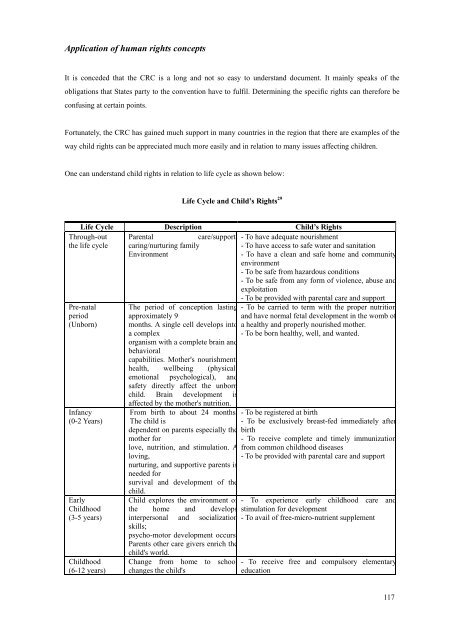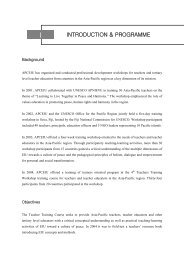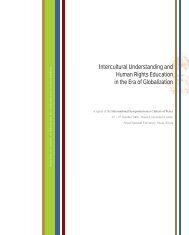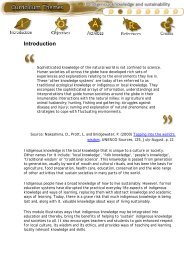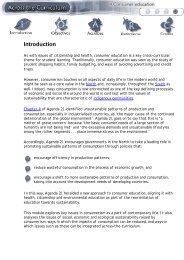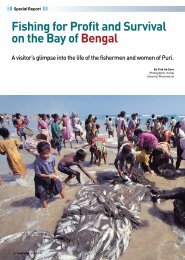REPORT OF UNESCO EXPERT MEETING ON - APCEIU
REPORT OF UNESCO EXPERT MEETING ON - APCEIU
REPORT OF UNESCO EXPERT MEETING ON - APCEIU
You also want an ePaper? Increase the reach of your titles
YUMPU automatically turns print PDFs into web optimized ePapers that Google loves.
Application of human rights concepts<br />
It is conceded that the CRC is a long and not so easy to understand document. It mainly speaks of the<br />
obligations that States party to the convention have to fulfil. Determining the specific rights can therefore be<br />
confusing at certain points.<br />
Fortunately, the CRC has gained much support in many countries in the region that there are examples of the<br />
way child rights can be appreciated much more easily and in relation to many issues affecting children.<br />
One can understand child rights in relation to life cycle as shown below:<br />
Life Cycle and Child’s Rights 29<br />
Life Cycle Description Child’s Rights<br />
Parental<br />
care/support,<br />
caring/nurturing family<br />
Environment<br />
Through-out<br />
the life cycle<br />
Pre-natal<br />
period<br />
(Unborn)<br />
Infancy<br />
(0-2 Years)<br />
Early<br />
Childhood<br />
(3-5 years)<br />
Childhood<br />
(6-12 years)<br />
The period of conception lasting<br />
approximately 9<br />
months. A single cell develops into<br />
a complex<br />
organism with a complete brain and<br />
behavioral<br />
capabilities. Mother's nourishment,<br />
health, wellbeing (physical,<br />
emotional psychological), and<br />
safety directly affect the unborn<br />
child. Brain development is<br />
affected by the mother's nutrition.<br />
From birth to about 24 months.<br />
The child is<br />
dependent on parents especially the<br />
mother for<br />
love, nutrition, and stimulation. A<br />
loving,<br />
nurturing, and supportive parents is<br />
needed for<br />
survival and development of the<br />
child.<br />
Child explores the environment of<br />
the home and develops<br />
interpersonal and socialization<br />
skills;<br />
psycho-motor development occurs.<br />
Parents other care givers enrich the<br />
child's world.<br />
Change from home to school<br />
changes the child's<br />
- To have adequate nourishment<br />
- To have access to safe water and sanitation<br />
- To have a clean and safe home and community<br />
environment<br />
- To be safe from hazardous conditions<br />
- To be safe from any form of violence, abuse and<br />
exploitation<br />
- To be provided with parental care and support<br />
- To be carried to term with the proper nutrition<br />
and have normal fetal development in the womb of<br />
a healthy and properly nourished mother.<br />
- To be born healthy, well, and wanted.<br />
- To be registered at birth<br />
- To be exclusively breast-fed immediately after<br />
birth<br />
- To receive complete and timely immunization<br />
from common childhood diseases<br />
- To be provided with parental care and support<br />
- To experience early childhood care and<br />
stimulation for development<br />
- To avail of free-micro-nutrient supplement<br />
- To receive free and compulsory elementary<br />
education<br />
117


